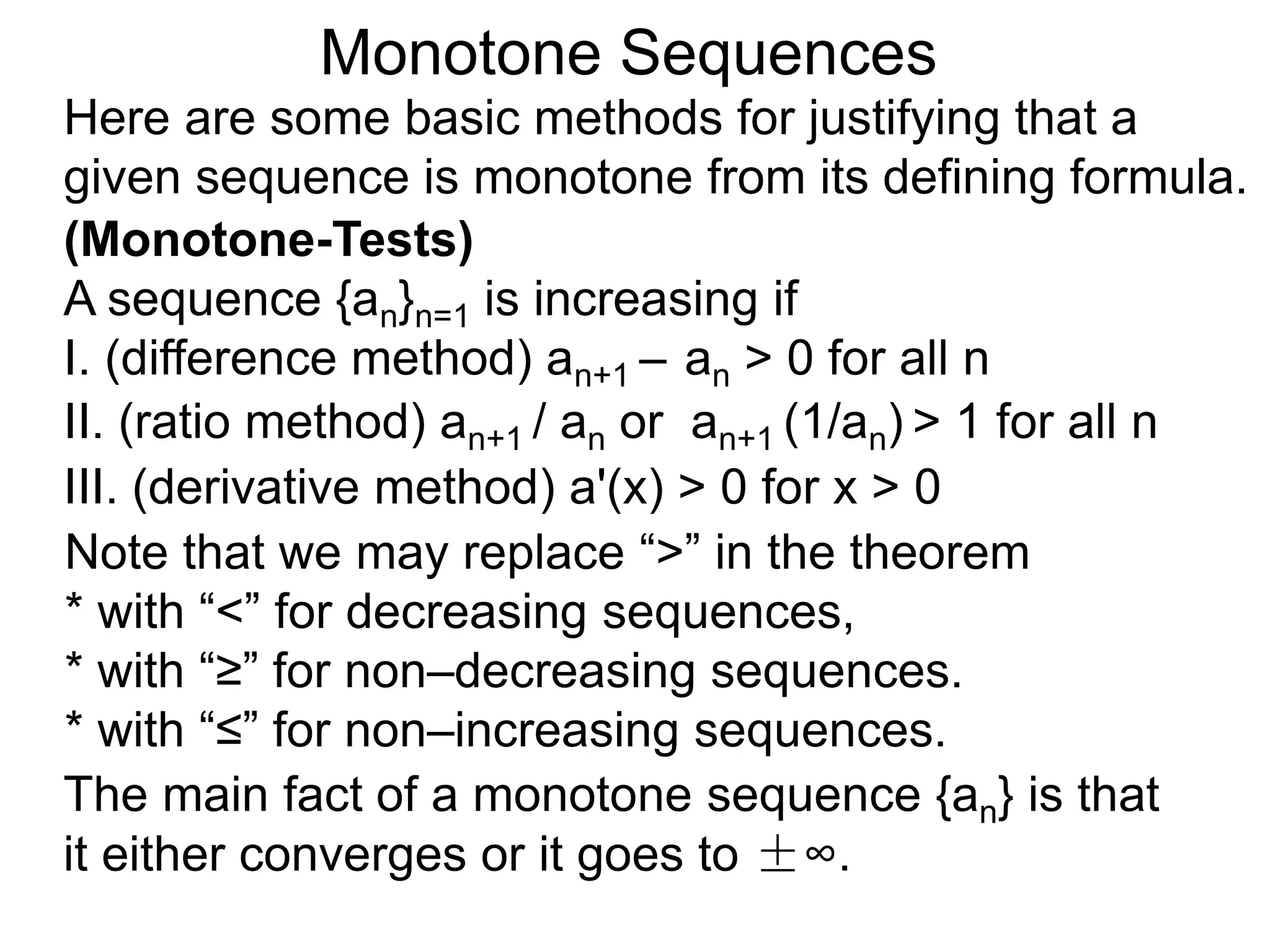The document defines and discusses monotone sequences. A sequence {an} is defined as increasing if an < an+1, non-decreasing if an ≤ an+1, decreasing if an > an+1, and non-increasing if an ≥ an+1. Methods for determining if a sequence is monotone include the difference method, ratio method, and derivative method. Bounded and eventually monotone sequences are shown to converge according to the monotone sequence convergence theorem.











































![Monotone Sequences
2n+1
1 + 3n+1
– 2n
1 + 3n
=
LCD = (1 + 3n+1)(1 + 3n)
2n+1(1 + 3n) – 2n(1 + 3n+1) / LCD
= 2n[2(1 + 3n) – (1 + 3n+1)] / LCD
We will show that an+1 – an < 0:
Example C. Show that { } converges.2n
1 + 3n](https://image.slidesharecdn.com/21monotonesequences-x-190326184511/75/21-monotone-sequences-x-44-2048.jpg)
![Monotone Sequences
2n+1
1 + 3n+1
– 2n
1 + 3n
=
LCD = (1 + 3n+1)(1 + 3n)
2n+1(1 + 3n) – 2n(1 + 3n+1) / LCD
= 2n[2(1 + 3n) – (1 + 3n+1)] / LCD
= 2n[2 + 2*3n – 1 – 3n+1] / LCD
We will show that an+1 – an < 0:
Example C. Show that { } converges.2n
1 + 3n](https://image.slidesharecdn.com/21monotonesequences-x-190326184511/75/21-monotone-sequences-x-45-2048.jpg)
![Monotone Sequences
2n+1
1 + 3n+1
– 2n
1 + 3n
=
LCD = (1 + 3n+1)(1 + 3n)
2n+1(1 + 3n) – 2n(1 + 3n+1) / LCD
= 2n[2(1 + 3n) – (1 + 3n+1)] / LCD
= 2n[2 + 2*3n – 1 – 3n+1] / LCD
= 2n[1 + 3n (2 – 3)] / LCD
We will show that an+1 – an < 0:
Example C. Show that { } converges.2n
1 + 3n](https://image.slidesharecdn.com/21monotonesequences-x-190326184511/75/21-monotone-sequences-x-46-2048.jpg)
![Monotone Sequences
2n+1
1 + 3n+1
– 2n
1 + 3n
=
LCD = (1 + 3n+1)(1 + 3n)
2n+1(1 + 3n) – 2n(1 + 3n+1) / LCD
= 2n[2(1 + 3n) – (1 + 3n+1)] / LCD
= 2n[2 + 2*3n – 1 – 3n+1] / LCD
= 2n[1 + 3n (2 – 3)] / LCD
= 2n[1 – 3n ] / LCD < 0 for n = 1, 2, 3 ..
We will show that an+1 – an < 0:
Example C. Show that { } converges.2n
1 + 3n](https://image.slidesharecdn.com/21monotonesequences-x-190326184511/75/21-monotone-sequences-x-47-2048.jpg)
![Monotone Sequences
2n+1
1 + 3n+1
– 2n
1 + 3n
=
LCD = (1 + 3n+1)(1 + 3n)
2n+1(1 + 3n) – 2n(1 + 3n+1) / LCD
= 2n[2(1 + 3n) – (1 + 3n+1)] / LCD
= 2n[2 + 2*3n – 1 – 3n+1] / LCD
= 2n[1 + 3n (2 – 3)] / LCD
= 2n[1 – 3n ] / LCD < 0 for n = 1, 2, 3 ..
We will show that an+1 – an < 0:
So the sequence is decreasing and it’s bounded
below by 0, hence it’s a CG sequence.
Example C. Show that { } converges.2n
1 + 3n](https://image.slidesharecdn.com/21monotonesequences-x-190326184511/75/21-monotone-sequences-x-48-2048.jpg)